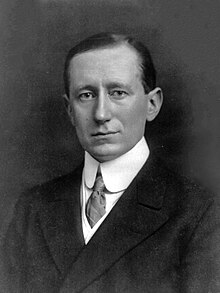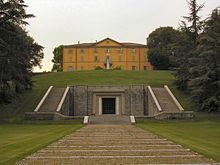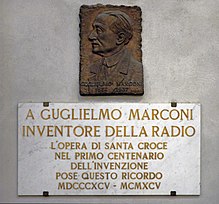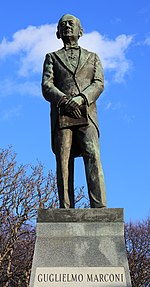Guglielmo Marconi
The Marchese Guglielmo Marconi | |
|---|---|
 Marconi in 1909 | |
| Born | Guglielmo Giovanni Maria Marconi 25 April 1874 |
| Died | 20 July 1937 (aged 63) Rome, Kingdom of Italy |
| Nationality | Italian |
| Alma mater | University of Bologna |
| Known for | Radio |
| Awards |
|
| Scientific career | |
| Academic advisors | Augusto Righi |
| Signature | |
Guglielmo Giovanni Maria Marconi, 1st Marquis of Marconi FRSA (Italian: [ɡuʎˈʎɛlmo marˈkoːni]; 25 April 1874 – 20 July 1937) was an Italian[1][2][3][4] inventor and electrical engineer, known for his creation of a practical radio wave–based wireless telegraph system.[5] This led to Marconi being credited as the inventor of radio,[6] and he shared the 1909 Nobel Prize in Physics with Karl Ferdinand Braun "in recognition of their contributions to the development of wireless telegraphy".[7][8][9]
Marconi was also an entrepreneur, businessman, and founder of The Wireless Telegraph & Signal Company in the United Kingdom in 1897 (which became the Marconi Company). In 1929, Marconi was ennobled as a Marchese (marquis) by King Victor Emmanuel III of Italy, and, in 1931, he set up Vatican Radio for Pope Pius XI.
\
Titanic
The role played by Marconi Co. wireless in maritime rescues raised public awareness of the value of radio and brought fame to Marconi, particularly the sinking of RMS Titanic on 15 April 1912 and RMS Lusitania on 7 May 1915.[56]
RMS Titanic radio operators Jack Phillips and Harold Bride were not employed by the White Star Line but by the Marconi International Marine Communication Company. After the sinking of the ocean liner, survivors were rescued by the RMS Carpathia of the Cunard Line.[57] Carpathia took a total of 17 minutes to both receive and decode the SOS signal sent by Titanic. There was a distance of 58 miles between the two ships.[58] When Carpathia docked in New York, Marconi went aboard with a reporter from The New York Times to talk with Bride, the surviving operator.[57] After this incident, Marconi gained popularity and became more recognised for his contributions to the field of radio and wireless technology.[59]
On 18 June 1912, Marconi gave evidence to the Court of Inquiry into the loss of Titanic regarding the marine telegraphy's functions and the procedures for emergencies at sea.[60] Britain's Postmaster-General summed up, referring to the Titanic disaster: "Those who have been saved, have been saved through one man, Mr. Marconi ... and his marvellous invention."[61] Marconi was offered free passage on Titanic before she sank, but had taken Lusitania three days earlier. As his daughter Degna later explained, he had paperwork to do and preferred the public stenographer aboard that vessel.[62]
Continuing work

Over the years, the Marconi companies gained a reputation for being technically conservative, in particular by continuing to use inefficient spark-transmitter technology, which could be used only for radio-telegraph operations, long after it was apparent that the future of radio communication lay with continuous-wave transmissions which were more efficient and could be used for audio transmissions. Somewhat belatedly, the company did begin significant work with continuous-wave equipment beginning in 1915, after the introduction of the oscillating vacuum tube (valve). The New Street Works factory in Chelmsford was the location for the first entertainment radio broadcasts in the United Kingdom in 1920, employing a vacuum tube transmitter and featuring Dame Nellie Melba. In 1922, regular entertainment broadcasts commenced from the Marconi Research Centre at Great Baddow, forming the prelude to the BBC, and he spoke of the close association of aviation and wireless telephony in that same year at a private gathering with Florence Tyzack Parbury, and even spoke of interplanetary wireless communication. In 1924, the Marconi Company co-established the Unione Radiofonica Italiana (now RAI).[63]
Later years
In 1914, Marconi was made a Senator in the Senate of the Kingdom of Italy and appointed Honorary Knight Grand Cross of the Royal Victorian Order in the UK. During World War I, Italy joined the Allied side of the conflict, and Marconi was placed in charge of the Italian military's radio service. He attained the rank of lieutenant in the Italian Royal Army and of commander in the Regia Marina. In 1929, he was made a marquess by King Victor Emmanuel III.[65]

While helping to develop microwave technology, the Marchese Marconi suffered nine heart attacks in the span of three years preceding his death.[66] Marconi died in Rome on 20 July 1937 at age 63, following the ninth, fatal, heart attack, and Italy held a state funeral for him. As a tribute, shops on the street where he lived were "Closed for national mourning".[67] In addition, at 6 pm the next day, the time designated for the funeral, transmitters around the world observed two minutes of silence in his honour.[68] The British Post Office also sent a message requesting that all broadcasting ships honour Marconi with two minutes of broadcasting silence.[67] His remains are housed in the Mausoleum of Guglielmo Marconi in the grounds of Villa Griffone at Sasso Marconi, Emilia-Romagna, which assumed that name in his honour in 1938.[69]
In 1943, Marconi's elegant sailing yacht, the Elettra, was commandeered and refitted as a warship by the German Navy. She was sunk by the RAF on 22 January 1944. After the war, the Italian Government tried to retrieve the wreckage, to rebuild the boat, and the wreckage was removed to Italy. Eventually, the idea was abandoned, and the wreckage was cut into pieces which were distributed amongst Italian museums.
In 1943, the Supreme Court of the United States handed down a decision on Marconi's radio patents restoring some of the prior patents of Oliver Lodge, John Stone Stone, and Nikola Tesla.[70][71] The decision was not about Marconi's original radio patents[72] and the court declared that their decision had no bearing on Marconi's claim as the first to achieve radio transmission, just that since Marconi's claim to certain patents was questionable, he could not claim infringement on those same patents.[73] There are claims the high court was trying to nullify a World War I claim against the United States government by the Marconi Company via simply restoring the non-Marconi prior patent.[70]
Personal life

Marconi was a friend of Charles van Raalte and his wife Florence, the owners of Brownsea Island; and of Margherita, their daughter, and in 1904 he met her Irish friend, The Hon. Beatrice O'Brien (1882–1976), a daughter of The 14th Baron Inchiquin. On 16 March 1905, Beatrice O'Brien and Marconi were married, and spent their honeymoon on Brownsea Island.[74] They had three daughters, Lucia (born and died 1906), Degna (1908–1998), and Gioia (1916–1996), and a son, Giulio, 2nd Marchese Marconi (1910–1971). In 1913, the Marconi family returned to Italy and became part of Rome society. Beatrice served as a lady-in-waiting to Queen Elena. At Marconi's request, his marriage to Beatrice was annulled on 27 April 1927, so he could remarry.[75] Marconi and Beatrice had divorced on 12 February 1924 in the free city of Fiume (Rijeka).[11]

Marconi went on to marry Maria Cristina Bezzi-Scali [it] (2 April 1900 – 15 July 1994), the only daughter of Francesco, Count Bezzi-Scali. To do this he had to be confirmed in the Catholic faith and became a devout member of the Church.[76] He was baptised Catholic but had been brought up as a member of the Anglican Church. On 12 June 1927, Marconi married Maria Cristina in a civil service, with a religious ceremony performed on 15 June. Marconi was 53 years old and Maria Cristina was 26. They had one daughter, Maria Elettra Elena Anna (born 1930), who married Prince Carlo Giovannelli (1942–2016) in 1966; they later divorced. For unexplained reasons, Marconi left his entire fortune to his second wife and their only child, and nothing to the children of his first marriage.[77]
Marconi wanted to personally introduce in 1931 the first radio broadcast of a Pope, Pius XI, and did announce at the microphone: "With the help of God, who places so many mysterious forces of nature at man's disposal, I have been able to prepare this instrument which will give to the faithful of the entire world the joy of listening to the voice of the Holy Father".[78]
Fascism
Marconi joined the National Fascist Party in 1923.[79] In 1930, Italian dictator Benito Mussolini appointed him President of the Royal Academy of Italy, which made Marconi a member of the Fascist Grand Council. Marconi was an apologist for fascist ideology and actions such as the Italian invasion of Ethiopia in the Second Italo-Abyssinian War.[80]
In his lecture he stated: "I reclaim the honour of being the first fascist in the field of radiotelegraphy, the first who acknowledged the utility of joining the electric rays in a bundle, as Mussolini was the first in the political field who acknowledged the necessity of merging all the healthy energies of the country into a bundle, for the greater greatness of Italy".[81]
In 2002 researcher Annalisa Capristo found documents in the archives of Rome which showed that during his time as the President of the Royal Academy of Italy, Marconi had marked by hand Jewish applicants' records with an "E", where in the Italian language word for Jew is "Ebreo". Not one Jew was allowed to join during Marconi's tenure as president from 1930, three years before Adolf Hitler took power in Germany and eight years before Benito Mussolini's race laws brought his regime's antisemitism into the open. Following publication of Capristo's article "The Exclusion of Jews From the Academy of Italy" published in the Israel Monthly Review, historians were divided over whether the discrimination was the personal initiative of a scientist who considered Jews inferior or whether it was the action of a man too weak to oppose the regime's edicts.[82]
Legacy and honours
Archives
- A large collection of Marconi artefacts was held by The General Electric Company, plc (GEC) of the United Kingdom which later renamed itself Marconi plc and Marconi Corporation plc. In December 2004 the extensive Marconi Collection, held at the former Marconi Research Centre at Great Baddow, Chelmsford, Essex UK was donated to the nation by the Company via the University of Oxford.[83] This consisted of the BAFTA award-winning MarconiCalling website, some 250+ physical artefacts and the massive ephemera collection of papers, books, patents and many other items. The artefacts are now held by The Museum of the History of Science and the ephemera Archives by the nearby Bodleian Library.[84] Following three years' work at the Bodleian, an Online Catalogue to the Marconi Archives was released in November 2008.

Orders and decorations
- Italian
- Knight of the Order of Merit for Labour (26 October 1902)[85]
- Knight of the Civil Order of Savoy (1 June 1905)[85]
- Grand Cordon of the Order of the Crown of Italy (7 April 1913; Grand Officer: 30 October 1902; Officer: 6 January 1898)[85]
- Grand Cordon of the Order of Saints Maurice and Lazarus (14 January 1932; Grand Officer: 30 May 1912; Commander: 12 January 1902)[85][86][65]
- Marquis of Marconi (17 July 1929)[85]
- Others
- Grand Cross of the Order of Saint Anna of the Russia Empire (1902)[87][65]
- Honorary Knight Grand Cross of the Royal Victorian Order of the United Kingdom (GCVO, 1914)[65]
- Grand Cross of the Civil Order of Alfonso XII of Spain[85]
- Grand Cordon of the Order of the Rising Sun of Japan (1933)[88]
Honours and awards

- In 1901, he was elected as a member of the American Philosophical Society.[89]
- In 1903, Marconi also received the freedom of the City of Rome.[65]
- In 1909, Marconi shared the Nobel Prize in Physics with Karl Ferdinand Braun for their "contributions to the development of wireless telegraphy" (radio communications).[7]
- In 1914, Marconi was named senator by the king of Italy Vittorio Emanuele III[65]
- In 1918, he was awarded the Franklin Institute's Franklin Medal.[90]
- In 1920, he was awarded the IRE Medal of Honor, now the IEEE Medal of Honor.[91]
- In 1931, he was awarded the John Scott Medal by the Franklin Institute and the City Council of Philadelphia.[92]
- In 1934, he was awarded the Wilhelm Exner Medal.[93]
- In 1974, Italy marked the birth centennial of Marconi with a circulating commemorative Lire 100 coin.[94]
- In 1975, Marconi was inducted into the National Inventors Hall of Fame.[95]
- In 1978, Marconi was inducted into the NAB Broadcasting Hall of Fame.[96]
- In 1988, the Radio Hall of Fame (Museum of Broadcast Communications, Chicago) inducted Marconi as a Pioneer (soon after the inception of its awards).[97]
- In 1990, the Bank of Italy issued a Lire 2,000 banknote featuring his portrait on the front and on the back his accomplishments.[98]
- In 2001, Great Britain released a commemorative £2 coin celebrating the 100th anniversary of Marconi's first wireless communication.[99]
- Marconi's early experiments in wireless telegraphy were the subject of two IEEE Milestones; one in Switzerland in 2003[100] and most recently in Italy in 2011.[101]
- In 2009, Italy issued a commemorative silver 10 Euro coin honouring the centennial of Marconi's Nobel Prize.[102]
- In 2009, he was inducted into the New Jersey Hall of Fame.[103]
- The Dutch radio academy bestows the Marconi Awards annually for outstanding radio programmes, presenters and stations.[104]
- The National Association of Broadcasters (US) bestows the annual NAB Marconi Radio Awards also for outstanding radio programmes and stations.[105]
Tributes


- A funerary monument to the effigy of Marconi can be seen in the Basilica of Santa Croce, Florence, but his remains are in the Mausoleum of Guglielmo Marconi in Sasso Marconi, Italy. His former villa, adjacent to the mausoleum is the Marconi Museum (Italy) with much of his equipment.
- A Guglielmo Marconi sculpture by Attilio Piccirilli stands in Washington, D.C.[106]
- A granite obelisk stands on the cliff top near the site of Marconi's Marconi's Poldhu Wireless Station in Cornwall, commemorating the first transatlantic transmission.
- Marconi Plaza Park, an urban park square named after the inventor in 1937, is located Philadelphia, Pennsylvania at Oregon Ave and South Broad Street. It includes a later 1975 bronze statue of Marconi erected on the east side.
Places and organisations named after Marconi
Outer space
The asteroid 1332 Marconia is named in his honour. A large crater on the far side of the Moon is also named after him.
Europe
- Bologna Guglielmo Marconi Airport (IATA: BLQ – ICAO: LIPE), of Bologna, is named after Marconi, its native son.
- Guglielmo Marconi University, a private, non-profit university in Rome.
- Ponte Guglielmo Marconi, bridge that connects Piazza Augusto Righi with Piazza Tommaso Edison, in Rome.
Oceania
Australia
- Australian football (soccer) and social club Marconi Stallions.
North America
Canada
- The Marconi's Wireless Telegraph Company of Canada (now CMC Electronics and Ultra Electronics), of Montreal, Quebec, Canada, was created in 1903 by Guglielmo Marconi.[107] In 1925 the company was renamed to the 'Canadian Marconi Company', which was acquired by English Electric in 1953.[107] The company name changed again to CMC Electronics Inc. (French: CMC Électronique) in 2001. In 2002, the company historical radio business was sold to Ultra Electronics to become Ultra Electronics TCS Inc., now doing business as Ultra Communications. Both CMC Electronics and Ultra Communications are still located in Montreal.
- The Marconi National Historic Sites of Canada was created by Parks Canada as a tribute to Marconi's vision in the development of radio telecommunications. The first official wireless message was sent from this location by the Atlantic Ocean to England in 1902. The museum site is located in Glace Bay, Nova Scotia, at Table Head on Timmerman Street.
United States
California
- Marconi Conference Center and State Historic Park, site of the transoceanic Marshall Receiving Station, Marshall.
- Marconi-RCA Bolinas Transmitting Station in Bolinas, California
- Station KPH, Marconi Wireless Telegraph Company of America in Inverness, California
Hawaii
- Marconi Wireless Telegraphy Station on Oʻahu's North Shore, briefly the world's most powerful telegraph station.[108]
Massachusetts
- Marconi Beach in Wellfleet, Massachusetts, part of the Cape Cod National Seashore, located near the site of his first transatlantic wireless signal from the United States to Britain. There are still remnants of the wireless tower at this beach and at Forest Road Beach in Chatham, Massachusetts.[109]
New Jersey
- New Brunswick Marconi Station, now the Guglielmo Marconi Memorial Plaza in Somerset, NJ. President Woodrow Wilson's Fourteen Points speech was transmitted from the site in 1918.
- Belmar Marconi Station, now the InfoAge Science History Center in Wall Township, NJ.
The Marconi Wireless Company of America, the world's first radio company, was incorporated in Roselle Park New Jersey, on West Westfield Avenue, on November 22, 1899.
New York
- La Scuola d'Italia Guglielmo Marconi on New York City's Upper East Side.
Pennsylvania
- Marconi Plaza, Philadelphia, Pennsylvania. Roman terrace-styled plaza originally designed by the architects Olmsted Brothers in 1914–1916, built as the grand entrance for the 1926 Sesquicentennial Exposition and renamed to honour Marconi.